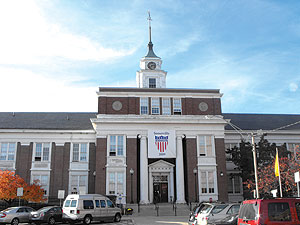 By Jeremy van der Heiden
By Jeremy van der Heiden
In a packed house with more than 100 residents and the full Board of Alderman Finance Committee present, Somerville Public Schools Superintendent Tony Pierantozzi gave a detailed analysis of the district’s budget plan for fiscal year 2014 this past Thursday, June 19, 2014. Although myriad items have been included in this year’s city budget plan, the school system remains as the single biggest investment.
For this reason and many more, members of the School Committee, students, teachers and administrators alike joined other Somervillians to hear Mr. Pierantozzi’s analysis. As has been the case for years, the school system maintained an exceptional level of transparency with its spending practices, outlining where every last sent is being allocated and for what purposes.
Before breaking down the budget pitch, though, the superintendent explained some of the successes that were experienced in the school system this past year. With a 91 percent graduation rate in 2014 compared to 84.5 percent only four years ago, students have been performing more consistently and prolifically throughout the past several years.
At the same time, the dropout rate has dropped consistently over the years, reaching a desirable 2.5 percent low in 2014 compared to 4.6 in 2010. SPS also became the only urban school in the state to reach a level-one classification.
More than three-quarters of class of 2014 graduates will be attending higher education facilities in the fall, while many students will also go on to technical and post-secondary.
Massachusetts Comprehensive Assessment System (MCAS) scores among Somerville students were among the highest in state, rising significantly and consistently since 2011 from the fortieth percentile to the sixtieth percentile in just two years.
As of the time of the meeting, Somerville students received more than $3.2 million for college and secondary schooling this year alone, comprised of several different full-tuition awards.
From an administrative standpoint, Superintendent Pierantozzi noted the reopening of the East Somerville Community School facility, which is now a state-of-the-art facility that saw its doors open on-time and under budget. The food and nutrition program has been another hallmark of the school system’s successes in the past few years.
For the budget, the superintendent stated that the budget is marked slightly below $70 million for fiscal year 2015, which is a slight increase from 2014. Operations expenditures, progressive programs for both early and post-high school students, more classroom construction, among several other novel pursuits account for much of the rise in the budget request.
The average teacher salary has actually decreased over the past two years, as younger staff members step in to replace retiring instructors. Despite some of the relevant challenges, elementary school class sizes have remained at a better-than-average level.
Mr. Pierantozzi noted that SPS is facing space issues given the dramatically increasing number of students that will be entering the district in the coming years.
Notably, Somerville has become one of the highest rated public schools in the state in several categories, while 66 percent of the 4,941 students in the district are considered to be in low-income households.
This essentially means that the students’ families are living below the federal poverty line, therefore placing them in the category of high-risk. Especially when compared to other urban districts, Somerville has remained resilient and steadfast in its pursuit of exceptional educational opportunities.
The superintendent also commended the community, including the Board of Aldermen, Mayor’s Office, local businesses, parents and more, for collaborative efforts to improve the school system through partnerships and general involvement.
“We are going to emphasize next year continuous improvement as we have in the past,” Superintendent Pierantozzi affirmed. “We have four focus areas: the whole child, particularly high risk, high need and high achievement students; early education; support for families; and targeted academic support with career and college-readiness for all students.”
Several BOA members were interested in learning more about the demographic breakdown of the schools, as well as the significant population of low-income families that were highlighted in the budget hearing. The superintendent answered the questions quickly, while the discussion remained centered around this topic.
After commending the School Committee for its detailed, exhaustive and diligent budget that was the product of immense fiscal responsibility, BOA President William White offered his insights.
“In many ways, we are a tale of two cities,” he asserted. “It falls on the shoulders of this board to try to make decisions so that we don’t have disparity and that we can try to work forward in certain areas … it’s important in decisions that this board makes in areas such as housing that we ensure we have appropriate programs for all of our youth to promote Somerville as a place where families want to remain, where they feel confident in having their children educated here.”
After recessing the school department’s budget presentation, a public hearing was held that allowed members of the community highlighted their concerns, many of which related to potential budget cuts in recreation programs and human services. BOA members echoed the concerns, while the Finance Committee moved on to other components of the FY 2015 budget review.
The Finance Committee is now wrapping up the review of the City of Somerville budget, and a breakdown of the resource and financial allocations remains forthcoming.













Reader Comments